Testing the CORE Body Temperature Monitor: Unlock Your Heat Training Potential and Optimize Performance

Over the last few weeks, I’ve had the opportunity to test the CORE Body Temperature Monitor. This is a device which is strapped around the chest and will measure your heat flux energy and skin temperature as a base for some algorithmic calculations to approximate the current core body temperature.
What Is a Core Body Temperature Monitor?
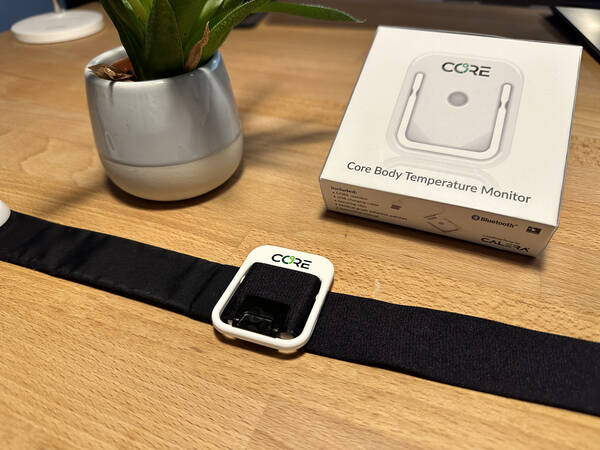
First of all, this device is used mainly to gain training benefits, as far as I’m aware. There’s no use case apart from that right now. Recent developments in the sector have shown the effects of collecting and relating training data are not to be underestimated. The athletes who use a science-backed training approach and are able to correlate as many of their body’s measurable performance responses as possible, have an advantage. This is true for both professionals as well as amateur athletes, of course. In the professional context, the most often mentioned people are those at the top of the Norwegian triathlon team, namely Gustav Iden and Kristian Blummenfelt, both recent World Champions of IRONMAN long distance triathlons.
In various interviews they speak about their data driven approach to training, which includes taking measure of the body’s core temperature and how it reacts to training. I’ve heard them state that before CORE, they used something called an “e-pill” which is a little capsule containing a bluetooth chip and which needs to be inserted into the body either orally, or, you know, in the rear end. It goes without saying that those can’t be reused that well. And Gustav Iden has stated that when you’ve got the sensor in your stomach and drink ice-cold water, the temperature will go down because of the water touching the sensor directly, giving you the illusion of your core temperature dropping, when in fact is hasn’t, at least not by that much.
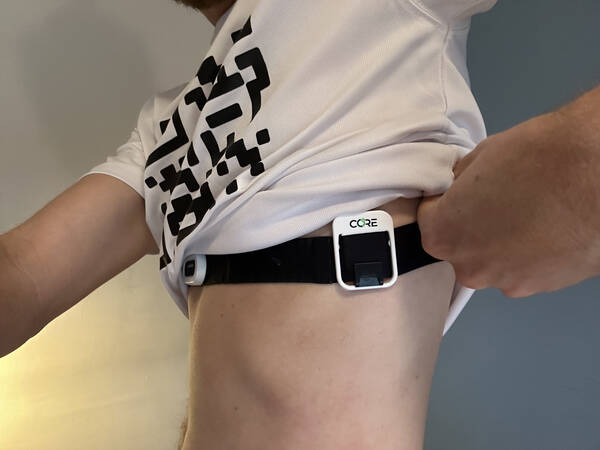
How Can This Sensor Work on the Outside of the Body?
To combat this problem, CORE has decided on a different approach. Measuring the core temperature inside the body is more accurate, yes, but the temperature can be derived from the energy flowing in and out of the body as well. The monitor uses a small heat flux sensor to get the amount of energy in Watts circulating in your skin and calculates the core body temperature using an algorithm the company came up with.
The skin temperature is also measured, but the data is used to display the Heat Strain Index, a separate measure which helps to understand how hard the body is working to cool down.
The people at CORE have used test subjects using both types of sensors simultaneously in order to improve their results, and the results seem to be very accurate. So, the gathered and displayed data is more or less reliable, at least to the degree that you can reasonably work with it.
It’s important to note that just using a skin temperature sensor like many watches have included won’t give you the core temperature when using the algorithm: You need the heat flux sensor to measure the actual Watts in your skin like this monitor does.
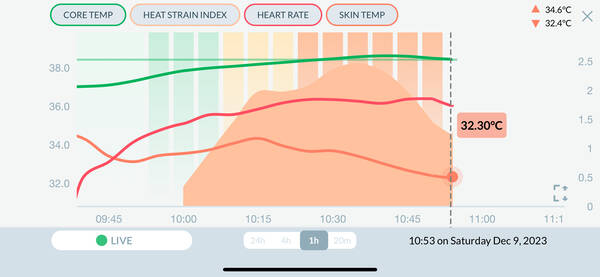
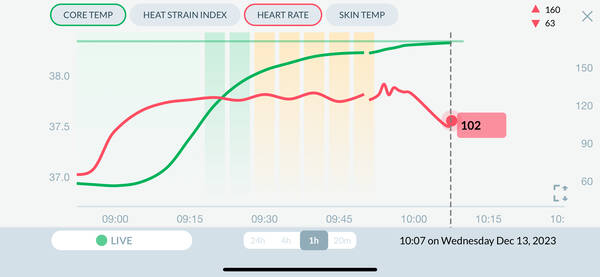
What Can You Learn From Your Body’s Core Temperature?
As far as I can tell, there are two main use cases. One is to keep the awareness of your body’s temperature preventatively in order to avoid overheating during races or training runs in hot conditions. This is useful if you’re training for a summer race or a race in a hot climate – like the Hawaii IRONMAN Championships, or, in my case, once I get selected for the Western States Endurance Run. The 40C+ degrees (105+ F) heat in the Californian canyons has brought many runners down and not everyone has the option to put a treadmill in a sauna during training.
Interested in more product reviews like these?
Subscribe to the free newsletter here:
You’ll never ever receive spam email and you can unsubscribe at any point.
-
This was one of the best articles I've read so far in telling about a race. I couldn't put it down. Your details were so awesome. You made New York just come alive.
-
Great review, enjoyed reading it and recognize lots off related subjects and hurtles. I’m amazed by all your running and races well done.
-
Great article! I've read so many long blogs only to get bored in the middle as I suffer terribly from ADD and move on to other things. Yours has been one of few that held my attention all the way to the end.
-
Your good humor and ease in telling stories make this blog a really cool space. Nice review.
-
Amazing effort Tim, well done! Thank you for taking the time to write down your thoughts, feelings and memories from the event. There’s always something to learn from your posts and this one was no exception!! Another cracking read.
-
What a ride! Surely the race, but also reading about it. Thanks for taking the time to write up such a detailed report, almost feel like I was there.
Via a test, the CORE sensor allows you to find out your personal heat training area in which your heat resistance improves. You can then try to keep running or cycling in such a way that your core temperature stays in that region.
Training in order to up your heat resistance has the added side effect of increasing the body’s blood plasma production, which has numerous advantages, among them are:
- Improved circulation: nutrients, hormones, oxygen, and anything the blood transports, will be more efficiently delivered.
- Enhanced immune response: our plasma also contains antibodies which fight off viruses and bacteria.
- Better hydration: more blood plasma means more water in your body. Good hydration is important for overall health.
- Faster healing: blood plasma carries the clotting factors and platelets that help heal wounds, so more of it will speed up the process.
- Last not least, the performance-related benefits: In addition to resulting in less blood being diverted from the muscles for cooling, it also increases your sweat rate, lowers the threshold for the onset of sweating, and decreases the amount of sodium in your sweat.
Heat training has been a staple in many coaches’ plans for a long time, but it’s usually been done in an experimental and unscientific way, such as a coach telling the athlete to just put on lots of warm clothes and run hard. It goes without saying that these methods were highly inaccurate and the benefits negligible before the CORE sensor came along.
I got to speak to Brian Maiorano, whose position is Coach Liaison at CORE. This means he talks to coaches in order to help them understand better how to work with the monitor in training.

How Do I Use the Monitor?
The sensor easily pairs with your bluetooth enabled GPS watch and your phone at the same time. For best accuracy it needs to be paired with a heart rate monitor directly, because there’s some interaction between both measurements. I didn’t know that at first and wondered about some seemingly weird data coming in, but this solved the problem. The new data fields which the monitor provides can be shown on your watch or bike computer so they are always available.
In addition to the training and health benefits, the CORE device also acts as a safety device and can help us notice overheating before it’s not possible to cool down anymore and irreversibly lose power output. Since our brains tend to work less well when overheating, this is a solid advantage as well, especially during a race where the adrenalin might cloud our feel for our body’s needs.
Does It Make Sense to Buy One?
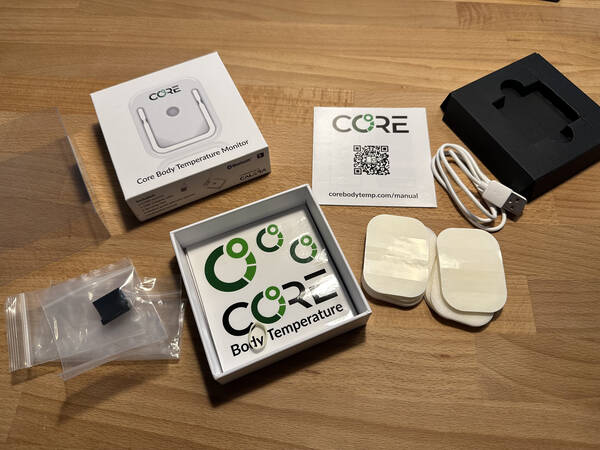
It depends on what your goals are. You’d need to be either a professional or an ambitious athlete or an athlete who is planning to do a race during major heat in the future. For my personal plans of someday doing the Western States 100, this will come in very handy and I’ll most probably incorporate heat training in this measured way into the mix, but as of right now, living in central Europe and a bit on the northern side, even the summer races here rarely cross the 25C barrier (77F), which is mostly okay for me.
Here’s some additional info about the CORE Body Temperature Monitor.
You can pick up the sensor if that sounds beneficial to your training goals at corebodytemp.com. Thanks a lot for reading – all the best to you and have a great day!
How do you feel after reading this?
This helps me assess the quality of my writing and improve it.
Leave a Comment